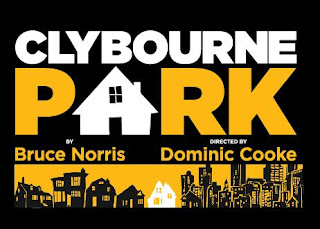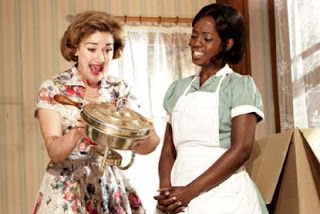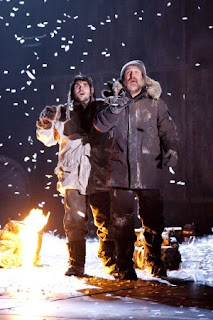Apr 12, 2011 | theater
 |
| My ticket! |
Once upon a time, there were hundreds and hundreds of fairytales. Some of them were about heroic princes and their damsels in distress, and some were about horrible monsters and magical fairies. But only one was about a magical clock and an idea bigger than a pretty dress or dashing good looks. Hans Christian Andersen’s story, The Most Incredible Thing, is finally getting told through the beautiful art of modern dance, with the Pet Shop Boys’ new ballet that premiered at Sadler’s Wells this past March.
 |
| The workers in the opening scene |
As the lights came up on stage, two lines of workers ran down both sides of a long table, all dancing in flawless robotic movements that rippled through like a wave. Choreographer Javier De Frutos did an amazing job interpreting this fairytale kingdom into movements and pirouettes. Even through the very first number, it was clear that this ballet became more than just the one page fairytale it represented: the kingdom was made of paper, fragile and breakable, with the people oppressed and unhappy—very 1984. But perhaps the unhappiest of all was the Princess, danced by the adorable Clemmie Sveaas, whose hand in marriage in addition to half the kingdom was offered up by her father in his search for the most incredible thing. In the first act, the pair danced a heartbreaking duet atop a table, where it was clear that the king was a father too, but he still did nothing to help his daughter, even as she whispered, “Help me,” to the audience.
 |
| God with his 10 Commandments inside the clock |
This search for the most incredible thing was facilitated by a contemporary kind of talent show, but even at the end of the first act, there were still no viable candidates. The most incredible thing had already been created by a young artist named Leo, played by Aaron Sillis, who was inspired, just as the audience was, by a dance with three beautiful muses in white. The second act of the ballet was the marvelous exhibition of Leo’s most incredible thing: a clock that held the whole world inside it, past, present, and future. Images and film footage on a center circle screen were combined with costumed dancers to prove the clock incredible—inside was nature, god with his ten commandments, the essence of music, the birth of technology, and life itself, represented by the heartbeat and images of an ultrasound. And even though the clock literally came to life on stage, it was clear that these dances were not as polished and refined as those at the beginning and end of the ballet—the only time during the performance where any sort of imperfection could be found.
Just like any other fairytale, this story has a bad guy and this ones name is Karl, danced by the former Royal Ballet Principal, Ivan Putrov. Putrov clearly had a different style of dancing from the others on stage, more classical and less willing to relax and give into the moment. Although this may have made him less fun to watch, every turn and every movement was impeccable. Karl, in classic bad guy fashion destroys this incredible clock, which supposedly makes him the most incredible instead. A very chauvinistic wedding dance follows; the line of women bow and bend to the will of the men, as deep red lights create a hellish glow behind them. But as it could have been guessed, the story ends happily and the muses return as the clock reassembles itself, deservedly destroying Karl as order and happiness is restored.
 |
| The adorable Clemmie Sveaas |
The entire production was just a mere glimpse at what can happen to the world of dance when combined with all the modern media that’s now available. The contemporary, beat-enthralled music of the Pet Shop Boys, striking film clips by Tal Rosner, and a live orchestra conduced by Dominic Wheeler, all morphed into one breathtaking artistic conglomerate that restored new life in an archaic fairytale, which may be the most incredible thing of all. It’s a shame the Princess is already married.
Mar 24, 2011 | theater
 “How many white men does it take to change a light bulb?”
“How many white men does it take to change a light bulb?”
The second act of Bruce Norris’ new play Clybourne Park is sprinkled with this kind of would-be offensive humor, showing how the innate racism within everyone can be covered up in the context of a joke. Which is really how the entire play functions, with Bruce Norris’ insanely clever writing and the actor’s hilarious delivery of lines making the audience laugh their way through this intense social commentary.
The play is performed in two acts, one in 1959 and the second in 2009, and each one juxtaposes the other perfectly, proving that it’s going to take a lot longer than fifty years for racism to disappear because the same issues and dialogue are still around. In the first act it’s pointed out that the black couple can’t ski, and in the second, the wife laughs at the idea of her white husband trying. And both revolve around the attempt to stop the other race from infiltrating ‘their’ neighborhood, in 1959 it was the blacks and in 2009 the whites, both acts echoing the same quote, “You can’t live in a principle.” Norris’ writing is what made the play so powerful, but it was the acting that made it a riot.
 The entire first act was performed under a shade of irony, with every character exuding a ‘Hi neighbor!’ characteristic indicative of what everyone thinks the fifty’s were like—according to I Love Lucy at least. Sophie Thompson as the wife Bev took the first act by storm, with her hilariously forceful voice and adorable naivety making her the most entertaining on the stage. But Sam Spruell who played the ever-so-helpful pastor Jim never once let his ridiculous smile fall, irony dripping from his mouth every time he spoke. But only Stuart McQuarrie as Bev’s husband Russ seemed like he could have actually existed, the sadness over the loss of his son pushing him away from the happy-go-lucky attitude of his wife and neighbors.
The entire first act was performed under a shade of irony, with every character exuding a ‘Hi neighbor!’ characteristic indicative of what everyone thinks the fifty’s were like—according to I Love Lucy at least. Sophie Thompson as the wife Bev took the first act by storm, with her hilariously forceful voice and adorable naivety making her the most entertaining on the stage. But Sam Spruell who played the ever-so-helpful pastor Jim never once let his ridiculous smile fall, irony dripping from his mouth every time he spoke. But only Stuart McQuarrie as Bev’s husband Russ seemed like he could have actually existed, the sadness over the loss of his son pushing him away from the happy-go-lucky attitude of his wife and neighbors.
With the changing of the acts came the complete reversal of the set, the once beautiful home now dilapidated and crumbling. And conducive to Norris’ echoing theme, the same actors played their 50-years-later counterparts, giving those with the quieter parts in the first act a chance to yell and scream and get offended. Which is exactly what happened as the tiptoe dance of political correctness pushed everyone to the edge. Sarah Goldberg as the pregnant wife Lindsey dominated the second act with her exclamations of “Half of my friends are black!” and “Well that was insulting,” her character serving as I’m-not-racist angel on everyone’s shoulder that whispers, ‘You better not tell that joke.’ But no matter how hard Lindsey tries to excuse her husband’s behavior, it is his bluntness that reveals the brilliantly made point of Clybourne Park: that the current obsession with political correctness doesn’t really make anybody colorblind.
Oh, and it takes one white man to hold the light bulb while the rest of them screw the entire world. Please don’t be offended.
Feb 6, 2011 | theater
 On my second venture to the National Theatre in London, I saw Greenland, a show about how we are responsible for climate change and the inevitable destruction of the earth. Well, it was pretty in your face to say the least. Which would have been fine, I get it, you have a message you need to get across, yadda yadda yadda, but the acting was pretty bad and the plot as a whole didn’t have much of a point.
On my second venture to the National Theatre in London, I saw Greenland, a show about how we are responsible for climate change and the inevitable destruction of the earth. Well, it was pretty in your face to say the least. Which would have been fine, I get it, you have a message you need to get across, yadda yadda yadda, but the acting was pretty bad and the plot as a whole didn’t have much of a point.
There were three main plot lines in total that alternated time on the stage. One of a naive teenage girl determined to save the planet, the second of a scientist who predicted that New York City will be under sea level by 2030 (and let me tell you, if that happens, I’m going down with it) who still wants to have kids anyways and spends most of the show trying to get the girl he likes to have his babies, and the third story follows a bird watcher in the arctic whose relationship with the teenage boy who accompanies him is never really explained. Kinda weird. But none of these plots really resolved themselves or went anywhere, and there were repetitive interrupting bits about basically nothing that were very distracting and made very little sense. One of these bits involved the Copenhagen Climate Conference in 2009 and the play very obviously blamed Obama for why it didn’t work. And there were other little jabs at America too which I wasn’t particularly fond of. (DON’T TREAD ON US.)

But perhaps the worst thing about this play was the general hypocrisy of it. The actors were basically screaming at us not to buy food from grocery stores because they come in plastic containers that fill up a waste island in the Pacific that is apparently as big as France, and crying that recycling isn’t good enough. But the entire time paper was falling from the ceiling and at the end of the play, a huge fan was turned on and the paper was literally blown into our faces. And even though they might reuse that paper play after play, when the show ends, what are they going to do with it? RECYCLE. Plus, the entire backdrop of the stage was a giant screen, and the power it required for one performance could have probably powered most of Manhattan for an hour. Not to mention the extreme number of props, most of which were unnecessary, and the money to buy them could have actually gone towards something that would actually help. But WHATEVER. The whole thing made me want to not recycle on purpose just to get back at them for wasting two hours of my life. But I suppose that’s how it is with most things that are shoved down our throats. Not only do we not want to eat it, we also want to throw up all over the ones doing the shoving.
Feb 2, 2011 | theater

Hamlet, the name all students shudder at when they see it on their high school English syllabus, is often hard to translate for a modern audience. But the National Theatre’s production I saw last Wednesday did a pretty great job. The XX’s song “Islands” played from Ophelia’s boom box, and the king was more of a president, with the desk and the press photos and the Secret Security and everything. And during the famous “to be or not to be” speech, Hamlet held a cigarette instead of a skull, something that seemed both fitting and badass at the same time.

The opening of the play made obvious the Frodo Baggins and Samwise Gamgee duo that is Horatio and Hamlet— Horatio, obviously serving as Sam in this metaphor since he’s the real hero and keeps everyone together while all Hamlet/Frodo does is freak out and complain. The image of Horatio holding Hamlet’s body at the end of the play is still in my head, and when he said his lines through his tears, it didn’t even seem like acting anymore. But Hamlet himself, his voice powerful and full of emotion, managed to deliver his lines with so much force, I felt my hair blown back, even though I was a good 30 meters from the stage.
The king’s ghost however, was by far my favorite, repeating the line “Remember me,” in a very Mufasa-from-The-Lion-King-like fashion as he faded off into wherever it is that dead spirits occupy when they’re not creeping the hell out of everyone. His voice was one of the only ones with an obvious mike, making him even spookier and giving him an air of omnipresence. And Ophelia, although seemingly the youngest of all the actors, was absolutely adorable, and her monologue in the first half broke the hearts of everyone in the audience who had one. And when she lost it at the end of the play, the mental instability of the character was so well acted that I’m sure she has at least 12 anti-crazy prescriptions from doctors who saw the show.

And for being one of Shakespeare’s great tragedies, there sure was a whole lot of laughing. Hamlet’s decent into “madness” cracked people UP. Apparently the British are super fond of the whole Monty-Python-girl-voice thing and random yelling and flailing about. I myself thought it was kind of dumb, but obviously the play wasn’t geared towards 19-year-old American girls who last read Hamlet three years ago because she had to. Still though, the lines themselves sounded so much more right when they were said with British accents.











